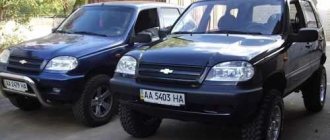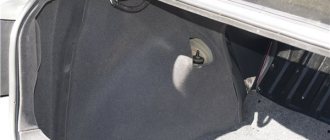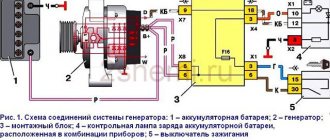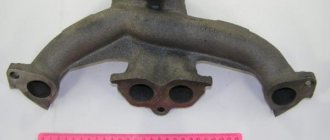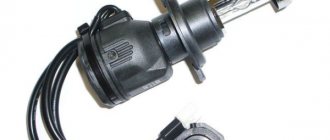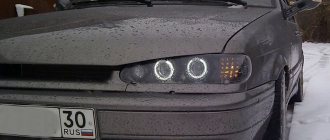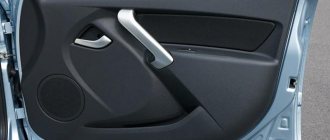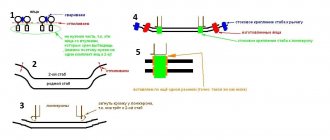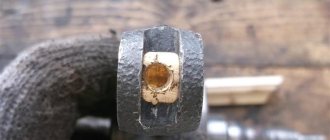Good afternoon, dear site visitors. In this article I will tell you and show you how to replace the VAZ 2107 torque rod bushings yourself. The replacement principle is the same for all Classic VAZ models.
In the previous article “Replacing torque rods of VAZ cars,” I showed how the rods are completely changed, but if only the rubber bushing (silent block) is worn out, then it makes sense to replace only that.
First, we need to carry out diagnostics and find out whether the bushings on all reaction rods need to be changed. How to correctly diagnose the front and rear suspension (chassis), I recommend that you read the special article (I will post a link later).
To perform this operation, we need an inspection hole. It's good that I have it. Previously, when she wasn’t there, I kept running to the neighbors to let me dig into my car, but now everything is much simpler.
Having rolled the car into the inspection pit, I determined that the rubber bushings on the transverse link had worn out. Now let's start working.
The first thing to do is remove the transverse torque rod. I took a metal brush and thoroughly cleaned all the threads on the bolts from dirt and treated them with WD-40.
Now that we have everything ready, I unscrewed both nuts without much difficulty.
Our next challenge was to pull out the bolts. Why the test? Because if the rubber band becomes loose, then moisture gets between the bolt and the metal sleeve and corrosion begins. All this leads to the fact that, under the influence of corrosion, the bolt sticks to the bushing and sometimes it is simply impossible to remove it.
In my case, I was very lucky and the bolts went in very easily. The left bolt came out perfectly, but the right one rested on the lower spring cup.
The photo above shows where the bolt rested. To remove the bolt, you need to load some scrap metal into the trunk or ask a friend to press down a little on the back of the car. This way, the bracket will go down a little and the bolt can be pulled out freely.
Now we just extract the traction, there should be no difficulties here. If the jet thrust is slow, you can help it with a pry bar.
Replacement of rubber bushings of torque rods.
To remove the rubber bushing, we need to knock out the metal inner race (bushing). After rummaging through my toolbox, I found a suitable attachment. I don't know what it is, but it fits just right. In my opinion, this is a tool for punching holes in the wall, like an ancient hammer drill :).
A few more blows and the bushing flew out along with the adapter. Here, be careful not to hit your fingers with a hammer when the bushing comes out sharply.
After all the efforts, this is the picture we get.
In the photo above you can see how the rubber bushings are cracked and this is not too much wear. With more wear, the inner metal clip falls out on its own and so does the rubber band.
The next step is to squeeze out the old gum. We will need a rod for extrusion and a support for the jet thrust.
I was too lazy to make a special puller, so after rummaging around in the garage I found a suitable tool.
Instead of a thrust bushing, I used a holder for large dies (which are used to cut threads), and for extrusion, I used an ordinary metal round timber with a diameter of 25 millimeters.
The photo above shows how I installed this structure. With a little force, the bushing will easily squeeze out.
In the photo above you can see how the bushing began to come out.
With a little more effort, she jumped out.
Preparation for installation of torque rod bushings.
Before installing a new bushing, be sure to clean out all dirt and rust inside the metal torque cage. If this is not done, then when pressing in the new bushing may get wrapped and damaged, which is not what we want. And the installation of the bushing itself will be problematic.
The internal bushings are also subject to wear and tear, and if they are very worn, then feel free to replace them with new ones.
If it is still suitable for further use, be sure to chamfer the edges.
This is necessary so that when we press in the metal bushings, they do not damage the rubber bushing. Why am I saying this because there were cases when I had to replace new rubber bushings due to their damage.
I bought new rubber bushings in advance. I didn’t try to buy expensive and branded bushings, because regular ones last quite a long time. Of course, you can buy expensive self-stabilizing ones, but I took simple ones.
Let's start installing the VAZ 2107 torque rod bushings.
In order for the bushing to easily fit into the thrust cage, it needs to be lubricated with soap. Then we install the bushing and torque rod, as shown in the photo below.
Under the influence of a vice, the bushing will go into place. When compressed, the elastic band will begin to bend in one direction and it would seem that it does not want to go in, but you don’t pay attention and squeeze further, it simply has no chance and it will eventually go in. The main thing in this matter is to quickly tighten the vice.
After the work done above, we got this result.
And now, the most important task remains. We need to press in the inner metal sleeve.
I made this bullet from a regular bolt. I happened to have a lathe and just sharpened the head of the bolt, but you can sharpen it with a sharpener.
I don’t remember exactly the thickness of the bolt, but, in my opinion, 10 millimeters. This bullet fits into the sleeve and looks like this.
We lubricate the bullet with soap and then, in the same way as before, crush the bushing with a vice.
Everything calmly falls into place, but since there is a bullet installed in the metal sleeve, it will not reach the end, because it will rest against the cheek of the vice.
Now we need a stand to press the bushing. I used an inch sleeve and it fit just right.
Having placed the coupling, we reseat the bushing.
After all the work done above, this is the result.
If the inner metal clip protrudes slightly on one side, you need to level it with a hammer.
And now all we have to do is install the rod in its place. Don’t forget to lubricate the bolts with nigrol, you never know what quality the rubber bands will be.
That's probably all, we replaced the VAZ 2107 torque rod bushings.
Until new publications.
Today we will tell you about the nuances, tips and secrets that VAZ classic owners use when replacing torque rods and rubber bushings of rear suspension rods. This entire article is based on both my personal experience and the experience of forum members. We have simply combined the main points on replacement and problems that you may have to encounter into one article and present it to you. If you still have any questions, you can ask us on the forum in the appropriate topic in the “Chassis” section. So - diagnostics. What can make us climb into the rear suspension? Extraneous knocks, strange behavior of the car, expressed in wobbling along the road. Carefully inspect the condition of the rubber bushings - they should not be nicked, torn, etc.
So I’ll say right away - replacing bushings is not a 5-minute task. In general, when replacing the bushings, I unscrewed each rod in turn and immediately after replacing, screwed it into place, then removed the next one. If you remove everything at once, installation may be difficult, since the bridge will move. Now I will describe the process itself - first I knocked out the metal bushings; some, due to the high wear of the rubber bands, fell out into my hands. Next, the rubber band - so as not to worry about pressing it out, I took a hacksaw for metal, removed the blade, threaded it into the hole where there was a metal sleeve, screwed it to the hacksaw and made two cuts so that a small piece of the sleeve fell out on its own, and then the remaining part was pulled out by hand. Pressing is more difficult...
You can use a pressing tool like this:
But you can go the other way. Initially, the rubber bushing is lubricated with a soap solution so that it “slips through” and then: the first method is to press it in a LARGE vice, sometimes not the first time, but it is pressed in; it is useless to press it in with your hands or a hammer. And if there is no vice, I used the weight of the car and a jack, that is, I laid down the rod, put a bushing soaked in the solution on it, then I put the jack on top of them and lifted the car with it. The machine uses its weight to press the rubber bushing into the rod. We perform the same manipulations with metal bushings.
Returning to the question of devices for pressing bushings, a ball from a bearing with a diameter slightly larger than the diameter of the bushing is very convenient; we place the ball on the bushing and press it in in a large vice, the ball carefully pushes the rubber band apart and the entire pressing occurs quickly and without any effort. I pressed it all the way, spread the vice, substituted something with a wider diameter than the bearing, I used the spread pliers, pressed it, and suddenly the ball was ready for new tests.
When disassembling (unscrewing) the rods, there are cases when the bolt has rusted to the metal sleeve, and there is no way to get it out of there... If you knock it out, then you have to scatter the floor of the bridge there. There is only one way out -
Bulgarian Cut exactly along the bushing. First, cut from the nut side, gradually turning the bolt, since the grinder will not be able to cut off the entire bolt in one go, then cut from the head side, also turning the bolt by the head. For ease of work, cut off the rod itself so that it does not interfere.
If on your penny, six or seven
When starting from a stop or driving on an uneven road, a knock appeared in the area of the rear axle and along with it the rear axle of the car lost stability, which means it’s time to check the condition and, if necessary, replace
the bushings of the rear rods (reactive rods)
.
Of course, you can take an easier route. And replace jet thrust
.
But this path, although easy, is not cheap. You can compare the price of a repair kit (metal and rubber bushings) for reaction rods and the price for a complete set of reaction rods. I think you will notice the difference. And why pay more if it's not necessary? If the reaction rods
are normal (not broken, not bent, the lugs are not broken), then you can simply replace the rubber bushings. Yes, and if you figure it out, it won’t be difficult for you to do this. All that is required from you is the desire to do the work yourself and prepare the tools and accessories that are necessary for the work.
First of all, about spare parts. You can immediately buy a set of rubber and metal bushings
.
A standard set of rubber bushings
for cars
VAZ-2101, VAZ-21011, VAZ-2102, VAZ-2103, VAZ-2104, VAZ-2105, VAZ-2106, VAZ-2107
consists of 10 pieces, four large and six small.
But I can advise you to buy a set of rubber bushings
for
the VAZ-2121 (Niva)
, in this set all the bushings are equally large.
Pressing them in is not much more difficult, but they can withstand the load better than standard ones. We also make sure to buy a set (10 pieces) of metal bushings (the old ones are often very worn out) - four large and six small. What do the rubber and metal bushings look like (pay attention to the color of the metal bushings, that’s the color we buy) look at photos No. 2. Of course, it’s better to buy new fasteners (bolts and nuts) too (especially if no one has worked on jet rods for a long time ), but here at your discretion or at the discretion of your wallet. Plus, you should buy a set of rubber bushings for the rear shock absorbers
.
As for the tool... Here you will need to have, at a minimum: two 19mm spanners, a hammer, a metal rod (useful for knocking out bolts when removing rods). But you will have to think about the devices for pressing out and pressing in the bushings in advance (since work without them will be much more complicated). You can either make them yourself (take a bolt of the appropriate diameter, screw on the nut and grind it to the size of the outer diameter of the metal sleeve) or buy (or order a turner) a ready-made tool (see photo No. 3 for what it looks like). Also, having a vice will make the work much easier.
1. Unscrew the nuts and remove (or knock out) the mounting bolts (photo No. 1). Let's relieve the traction.
2. If at one end of the rod the metal bushing can fall out on its own (photo No. 4), then at the other end the bushing will have to be knocked out using our pre-prepared device. (Photo No. 5). And, for example, we use a screwdriver to pry out the rubber bushing (photo No. 6).
3. Use a knife to clean the inside of the traction eye (photo No. 7).
4. Using a vice, press the rubber bushing into the rod
, having previously lubricated it and the rod eye
with soapy water
(photo No. 8).
Precisely with a soap solution and in no case using oil, since the bushings are NOT made from oil-gasoline resistant rubber.
And by lubricating them with oil, you will shorten their service life. 5. After this, using a “special tool” we press in the metal sleeve
, also lubricating it with soapy water, see photos No. 9 and No. 10.
In the absence of a “special tool”, a metal bushing,
just like
a rubber bushing
, can be pressed into a vice.
That's all! We carry out the same procedure with other rear links.
.
When installing jet rods on a car
, it is better to lubricate the mounting bolts, for example, with nigrol. Otherwise, the next repair of jet rods will turn into an exam in the skill of using an angle grinder!))
UPD 01/05/2016
Please love and favor - SEVI-Extreme torque rod bushings for VAZ-2101, VAZ-2102, VAZ-2104, VAZ-2105, VAZ-2106, VAZ-2107 cars manufactured by SEVI. I won’t be afraid to speak loudly and say that these bushings are the best of all possible options for torque rod bushings for Classics
.
I can say this with confidence, because as soon as these bushings appeared on the car market, I bought them and immediately installed them on my own dime. You can call this a pioneer experiment. In the photos below you can see in what packaging they were sold at first (initially the bushings were called SEVI-Spike
) and in what box these bushings can be found today.
Plus, a photo of the kit. And to say that I was surprised by the result of the experiment would not be correct. That's right - I was shocked! Yes, I had to tinker with pressing the bushings, but the result was simply amazing. The comfort that appeared in the rear axle of the car is difficult to describe in words. The rear of the car has become more solid and stable. The amount of noise transmitted from the car suspension to the body has been significantly reduced. Plus, you can add to this the high wear resistance of these bushings - for example, on my car they worked steadily for almost 30,000 km
. And none of the bushings failed. I can’t say exactly how long they lasted, since the car was sold.
After the tests, in my own car, it was the clients’ turn. Not everyone, however, agreed to install rubber-metal bushings for SEVI-Extreme jet rods.
Since the price of a set of these bushings upset even the most fanatical car enthusiast, who doted on his iron friend and never spared money on its maintenance and repair.
To make it clearer: the price of a set of these super bushings was (and is) equal to the price of a complete set of Chinese-made reaction rods. Or -60% of the cost of factory jet rods (rods) produced in Balakovo
. Something to think about...
But, despite the price issue, I have already managed to install these bushings on about a dozen cars. All car owners are happy and do not regret the money they spent.
That's why I recommend it to you! is nothing complicated about installing SEVI-Extreme torque rod bushings
.
Everything is the same as when working with standard bushings. But, there are some small features: the tie rod eyes of your car must be in good condition - not broken or destroyed by rust. Before pressing in the bushings, the eyes of the rods (rods) should be thoroughly cleaned. And only after that you can begin the installation. A bench vise is a must!
We treat the eyelet and bushing with a soapy solution. And slowly we begin to press it in.
This is how it was:
Here it is:
There is nothing complicated, as I said. The main thing is that the eyes are cleaned and do not fall apart from rust in your hands. And the result should please you. I would be glad if you share your impressions or your opinion about SEVI-Extreme bushings in the comments
.
When using an article or photographs, an active direct hyperlink to the website www.!
The basis of safe driving is the stability of the car on the road. This rule applies to both trucks and passenger cars. And the VAZ 2107 is no exception. The handling of this car has always left much to be desired. To somehow make life easier for drivers, engineers developed a jet thrust system for the “Seven”. But any part, as we know, can fail. And then the driver will be faced with the question: is it possible to change a broken rod with your own hands? Yes, you can. Let's try to figure out how this is done.
Purpose of thrust rods on the VAZ 2107
The purpose of the thrust rods on the VAZ 2107 is simple: to prevent the car from “walking” on the road and swaying strongly when entering sharp turns and when hitting various obstacles. This problem has been known since the days of early cars. They didn’t know about any jet thrust at that time, and the cars were equipped with ordinary springs. The result was natural: the car easily overturned, and it was incredibly difficult to drive. Over time, the car suspension was improved: a system of long rods began to be installed in it, which were supposed to take on part of the loads arising from road unevenness or due to an overly aggressive driving style. On the VAZ 2107 and other classic Zhiguli models, there are five jet rods: a pair of long ones, a pair of short ones, plus a large transverse rod, which serves as the basis of the entire traction system. All this is installed near the rear axle of the car.
This system can only be seen from the inspection hole, where all work on replacing broken rods is carried out.
Tie rod malfunctions
The jet thrust of the VAZ 2107, like any other car, takes on loads aimed at shifting or rocking the rear axle. If these parts fail, the car’s behavior on the road changes: handling deteriorates, braking distance increases, and even there is a threat of a sudden change in trajectory or the car overturning. What factors cause breakage or wear of steering rods?
- Static loads. It is impossible to avoid this factor, but you can reduce it without overloading the car.
- Torsional loads. They most often occur when hitting an obstacle. You can reduce them by reducing speed in front of an obstacle.
- Chemical effects of water and chemicals sprinkled on roads in winter.
Therefore, it is important to regularly check the condition of the rods and promptly detect deformation, chips and cracks. The appearance of such signs indicates the need to replace the part.
The rear links of the VAZ 2107 have weak points - welding seams that attach the eyes to the link and silent blocks. The latter are made of rubber, which wears out much faster than metal rod parts. Wear of silent blocks contributes to the appearance of backlashes that prevent the rods from performing their stabilizing function. As for the breakdown of a welded joint, it can lead to the most disastrous results, even an accident.
A failure of the torque rods manifests itself in a characteristic knocking sound in the rear suspension while driving. Such a knock indicates the need to immediately check the condition of the rear suspension.
To eliminate defects in steering rods, as well as to diagnose the suspension, you can contact a service station. But you should know that repairing and replacing these parts is a fairly simple operation that you can do yourself, even without much experience in auto repair work.
About the choice of jet thrusts
Currently, there are not many large manufacturers left that produce jet thrust for the VAZ 2107 and other classics. Their products differ in both price and reliability. Let's look at the most popular products.
Traction "Track"
The product is very popular among owners of the “Seven”. These rods are distinguished by their high reliability and high price, which starts from 2100 rubles per set.
The main difference between Trek is the heads for the bushings. Firstly, they are large, and secondly, they are attached to the rods by welding. The silent blocks on Tracks are also made of especially dense rubber, which significantly extends their service life.
Rods "Cedar"
The overwhelming majority of “Sevens” that had previously rolled off the assembly line had jet thrusters installed specifically from “Kedr”, since this company has always been and remains the official supplier of AvtoVAZ.
The quality of Kedr is somewhat inferior to Trek. This is especially true for bushings and silent blocks. All this wears out quite quickly, and therefore they will have to be changed more often. But there is also a good side - a reasonable price. A set of “Cedar” rods can be purchased for 1,700 rubles.
Belmag rods
Despite the simplicity and reliability of Belmag rods, they have one significant drawback: they are not so easy to find on sale. Every year they are found less and less often on the shelves of auto parts stores. But if the car owner still manages to find them, then he can be congratulated, since he got a reliable product at a reasonable price. The cost of Belmag rods starts from 1800 rubles per set.
This, in essence, is the entire list of large manufacturers of good rods for the VAZ 2107. Of course, now there are a lot of smaller companies on the market that are quite aggressively promoting their products. But none of these companies gained much popularity among the owners of classics, and therefore it is inappropriate to mention them here.
So what should a driver choose from all of the above?
The answer is simple: the only criterion for choosing jet rods is the thickness of the car owner’s wallet.
If a person is not short on funds, the best option would be to purchase Trek rods. Yes, they are expensive, but installing them will allow you to forget about problems with the suspension for a long time. If you don’t have enough money, it makes sense to look for products on the shelves. Well, if this idea is not crowned with success, there remains a third option - “Cedar” rods, which are sold everywhere.
Here we should say a few words about fakes. Knowing that car owners most often choose products from the three above-mentioned companies, unscrupulous manufacturers are now literally flooding the shelves with counterfeits. Moreover, in some cases, the fakes are made so skillfully that only a specialist can identify them. In such a situation, an ordinary driver can only focus on the price and remember: good things are expensive. And if there is a set of Trek rods on the counter for only a thousand rubles, then this is a serious reason to think about it. And don't rush into buying.
About modernization of jet thrusts
Sometimes drivers decide to independently increase the reliability of the VAZ 2107 suspension and extend its service life. To this end, they are modernizing jet thrust. Typically, modernization of rods means two operations. Here they are:
- installation of dual jet rods;
- installation of reinforced jet thrusts.
Now a little more about each of the above operations.
Twin rods
Most often, drivers install dual rods on the VAZ 2107. The reason is obvious: for this procedure you don't have to do anything with the pulls. You simply purchase not one, but two sets of rods that are installed in a regular place near the rear axle of the “seven”. Plus, you purchase not ordinary, but elongated mounting bolts, on which this entire structure rests.
The obvious advantage of such modernization is the increase in the reliability of the suspension: even if one of the tie rods breaks while driving, the car is unlikely to lose control and the driver will always have a chance to notice the problem in time and stop (a break in the tie rod is almost always accompanied by a strong knock on the bottom of the car, which cannot be heard this is simply impossible). This design also has a drawback: the suspension becomes stiffer.
If earlier it “eaten up” small unevenness in the road without any problems, now the driver will feel even small pebbles and holes while driving.
Reinforced traction
If the car is used in extreme conditions and drives mainly on dirt roads or on roads with very poor asphalt, the car owner can install enhanced torque rods on it. As a rule, drivers make such rods themselves. But recently, large manufacturers have begun to offer reinforced rods of their own production. For example, you can find Trek-Sport rods on sale, which are distinguished by the large size of silent blocks and an adjustable transverse rod. A pair of nuts on the crossbar allows you to slightly change its length. Which in turn affects the car’s handling and the overall stiffness of its suspension.
Of course, the driver will have to pay for increased reliability: the cost of a set of Track-Sport rods starts from 2,600 rubles.
Checking the condition of the jet rods on the VAZ 2107
Before we talk about checking jet thrusts, let’s ask ourselves: why is there a need for such a check at all? The fact is that when driving, jet rods are subjected to both lateral and torsional loads. Torsional loads occur when wheels hit large potholes or run over large rocks and other obstacles. This type of load is especially harmful for rods, or more precisely, for silent blocks in rods. It is the silent blocks that are the weak point of the jet thrust (there is simply nothing to break in the thrust itself: it is a metal rod with two eyes at the ends). In addition, the rubber parts of silent blocks are periodically exposed to reagents that are sprinkled on roads during icy conditions. As a result, cracks appear in the rubber and its service life is rapidly reduced.
If you believe the operating instructions, the new jet thrusts on the VAZ 2107 can travel at least 100 thousand km. But taking into account the conditions listed above, the actual service life of rods rarely exceeds 80 thousand km.
From the same instructions it follows that the state of the jet rods must be checked every 20 thousand km. However, car service technicians strongly recommend checking the rods every 10–15 thousand km in order to avoid extremely unpleasant surprises. To check the condition of the silent blocks in the rods, you will need an inspection hole and a mounting blade.
Test sequence
Video: checking jet rods on a VAZ 2107
Replacing jet rods on a VAZ 2107
Before starting work, we will decide on the necessary consumables and tools. Here's what we need:
- a set of new jet rods for the VAZ 2107;
- rust remover WD-40;
- mounting blades;
- set of open-end wrenches;
- hammer.
Sequence of work
First of all, two important points should be mentioned. Firstly, the rods should only be changed in an inspection pit or on an overpass. Secondly, all five rods from the VAZ 2107 are removed in exactly the same way.
That is why the procedure for dismantling only one central rod will be described below. To remove the remaining four rods, you just need to repeat the steps listed below.
- The car is installed above the inspection hole. The silent blocks, lugs and nuts on the central rod are carefully treated with WD40 (as a rule, the lugs rust very badly, so after applying the liquid you will have to wait 15-20 minutes for the composition to properly dissolve the rust).
- After the rust has dissolved, the area where WD40 was applied should be thoroughly wiped with a rag.
- Then, using a socket head with a ratchet, the nut on the silent block is unscrewed (it is best if it is a socket wrench with a ratchet handle, since there is very little space next to the rod). With a second 17-mm open-end wrench, it is necessary to hold the head of the bolt so that it does not turn when the nut is unscrewed.
- Once the nut is unscrewed, the mounting bolt is carefully knocked out with a hammer.
- A similar procedure is performed with the second silent block of the central rod. Once both mounting bolts are removed from their lugs, the rod is manually removed from the brackets.
- All other rods from the VAZ 2107 are removed in the same way. But when removing the side links, one nuance should be taken into account: after removing the mounting bolt, the upper edge of the wheel may fall outward. As a result, the holes on the silent block and on the mounting bracket are displaced relative to each other as shown in the figure below. And this creates serious problems when installing a new rod: the mounting bolt cannot be inserted into the bracket.
- If this is exactly the situation, then the wheel will have to be lifted using a jack until the holes on the bracket and on the silent block of the new linkage are aligned. Sometimes it is simply impossible to install a new lateral traction without this additional operation.
Video: changing jet engines on a VAZ 2107
Replacing silent blocks in the lower arm of a VAZ 2107, classic.
Here, when replacing, we can no longer do without an inspection hole or a lift.
To begin, use a 24mm wrench to unscrew the nuts securing the lever. Next, if you have a puller, then use it to press out the silent blocks. If there is no special puller, then we simply take a mandrel with a diameter larger than the diameter of the silent block. We set the mandrel as shown in the photo and hit it with a hammer. At the same time, we rest the lever using a mounting tool or a crowbar, as in the photo. Thus, we remove the silent blocks in the lower arms.
Remove silent blocks without a puller
How to remove stuck silent blocks in the lower front control arm.
Stuck silent blocks cause a lot of trouble when removing them. In order to get rid of them you need a gas torch and a hammer with a core. We burn out the rubber and tap the iron bushings on all sides. After that we try to knock them out using a core and a hammer.
If the nuts securing the lever shaft are not stuck, then it is better to completely remove the lever (this will make it easier to knock the bushings out of the shaft). To do this, you will also need to remove the ball from the hub. Above in the article there is a link on how to remove the ball joints.
Pressing silent blocks into the lower arm.
New silent blocks are pressed into the lever until it stops. This can be done using a puller or a mandrel of a suitable diameter; you can use a head as a mandrel.
After installing the new levers, tighten the nuts and release the car onto the wheels. Only after this do we fully tighten the nuts.
Of course, it will be clearer to see how everything is done once than to read it a hundred times. Especially for you, I am attaching a video about replacing silent blocks in the front arms of a rear-wheel drive VAZ.
Replacing bushings on VAZ 2107 rods
Bushings for VAZ 2107 torque rods are disposable products that cannot be repaired. It is not possible to restore a worn bushing in a garage.
The average car enthusiast has neither the necessary equipment nor the necessary skills to restore the inner surface of the bushing. Thus, the only option for repairing damaged traction bushings is to replace them with new ones. Here's what we need to replace the bushings on the rods:
- a device for pressing bushings (can be purchased at any auto parts store);
- hammer;
- beard with a diameter of 10 mm.
Sequencing
The rods are removed from the car according to the instructions outlined above. The lugs and silent blocks must be treated with WD40 liquid and thoroughly cleaned of dirt and rust using a wire brush.
- Usually, after removing the rod, the bushing is removed from it freely. But this only happens if it is very worn and not very rusty. If the bushing is literally welded to the rod due to rust, you will have to knock it out with a hammer, after inserting a bit into it.
- If the rubber part of the silent block is severely damaged, you will have to get rid of it too. These pieces of rubber can simply be torn out by prying them off with a screwdriver or a mounting spatula.
- Now the inner surface of the eye should be thoroughly cleaned with a sharp knife or sandpaper. There should be no rust or rubber residue left on the eyelet.
- Now a new bushing is installed in the eye (and if the rubber was removed, then a new silent block is installed). It is pressed into the eyelet using a special device.
- If you don’t have a pressing tool at hand, you can use the same bit. However, you will have to act very carefully so as not to damage the inner surface of the sleeve.
So, to replace jet rods on a VAZ 2107, the car owner does not have to take the car to the nearest service center. All the work can be done with your own hands. Even a novice car enthusiast who has held a hammer and wrench in his hands at least once can handle this. All you need to do is follow the above recommendations exactly.
Removing jet rods
Replacing jet rods on a VAZ 2107 consists of two stages: removing the old ones and installing new ones. The rods are removed as follows:
Note: if the nut cannot be unscrewed, the bolt must be cut off.
- Using a spudger, remove the torque rod.
- If the bolt has been cut, remove the remaining linkage fastenings.
Note: it is unacceptable to try to weld cracks on a cracked rod - the seam will not withstand the load. Therefore, cracked rods must be replaced.
